The realm of robotics is evolving at an unprecedented pace, bringing forth the dawn of industrial humanoid robots. These advanced machines promise to revolutionize the way industries operate by mimicking human functions to a remarkable degree. But how close are we really to seeing humanoid robots in our factories and workplaces?
The Concept of Industrial Humanoid Robots
Humanoid robots are not entirely novel; we have seen various prototypes and conceptual models in past decades. However, the industrial application of these robots is a fresh frontier. The primary allure of humanoid robots in an industrial setting is their ability to interact with human-centric environments more effectively than non-humanoid counterparts. Their structure allows them to perform tasks that require human-like dexterity and adaptability.
Breakthrough Proof-of-Concept
A recent proof-of-concept has revealed a potential pathway toward bringing these humanoid robots to industrial facilities. This development is significant as it showcases the viability of such robots in real-world applications, bridging the gap between theoretical capabilities and practical implementations. This breakthrough paves the way for more efficient, versatile, and adaptable automation solutions.
Key Benefits of Industrial Humanoid Robots
The integration of humanoid robots into industrial settings offers numerous advantages:
- Increased Flexibility: Humanoid robots can perform a wide variety of tasks, adapting swiftly to changes in the production line without extensive reprogramming.
- Enhanced Safety: These robots can undertake hazardous tasks, reducing the risk of injury to human workers.
- Higher Efficiency: Humanoid robots operate tirelessly and with precision, improving productivity and reducing operational costs.
Challenges to Overcome
While the potential benefits are substantial, several challenges need addressing before humanoid robots can operate seamlessly in industrial environments:
- Technical Limitations: Designing robots that truly replicate human dexterity and decision-making remains a complex engineering challenge.
- Cost Implications: The initial investment for these sophisticated machines can be significant, requiring careful consideration of ROI.
- Integration with Existing Systems: Seamlessly integrating humanoid robots with current industrial systems involves overcoming significant interoperability issues.
Real-World Applications: Current and Future
Humanoid robots hold immense promise across various sectors:
Manufacturing
In manufacturing, humanoid robots can take on assembly tasks that require the nuanced touch and precision typically associated with human workers. Their ability to operate machines and manage materials in an optimized fashion can revolutionize production lines.
Logistics and Warehousing
Warehouses can benefit considerably from humanoid robots, which can efficiently manage inventories, handle shipments, and even perform packing and unpacking tasks. This would minimize human errors and streamline logistics operations.
Healthcare
The healthcare sector is yet another area where humanoid robots could make a significant impact. From assisting in surgeries to providing care to patients, these robots can augment healthcare services, offering support in repetitive tasks and ensuring a higher level of hygiene and accuracy.
Looking to the Future
The journey towards full-scale adoption of humanoid robots in industry is just beginning. As the technology matures, several strategic steps can be expected:
- Increased R&D Investment: Companies and governments are likely to invest heavily in research and development to overcome current limitations and enhance capabilities.
- Strategic Partnerships: Collaborations between technology firms and industrial players will be vital for developing robots tailored to specific industry needs.
- Regulatory Frameworks: As humanoid robots become more prevalent, there will be a need for robust regulations to ensure safety and ethical use.
Conclusion
The advent of industrial humanoid robots signals a transformative era for automation. Their potential to replicate human actions and perform a multitude of tasks presents an exciting future for industries worldwide. As technological hurdles are overcome and adoption becomes widespread, these robots will not only complement human efforts but redefine the nature of work in the industrial landscape. The possibilities are boundless, and the journey has just begun.








